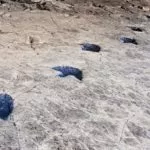
(BRAZIL) — Paleontologists have discovered a new species of ancient crocodile-like reptile that once roamed the lands and waters of Brazil.
The fossils, found in a fossiliferous locality named “Linha Várzea 2” in southern Brazil, have now been dubbed Parvosuchus aurelioi, a new ancient species of small predatory reptiles that date back approximately 237 million years ago, according to a paper published in Scientific Reports on Thursday.
The new species belongs to a group of crocodile-like reptiles called pseudosuchians and are the first “unequivocal” gracilisuchid, an extinct genus of tiny pseudosuchians, Rodrigo Müller, a paleontologist at the Universidade Federal de Santa Maria and lead author of the paper, told ABC News via email.
Before dinosaurs dominated the earth, pseudosuchians were a common form of reptile during the Triassic Period.
The fossils were discovered in fossiliferous beds that precede the ones housing the oldest dinosaurs, giving scientists clues on the “ecosystems that existed before the dawn of the dinosaur era,” Müller said.
“The presence of this small predator among fossils of much larger predators suggests that these ecosystems, where Brazil is located today, were more complex than previously imagined,” he said.
Gracilisuchids are extremely rare, Müller said, adding that there are only other three species worldwide: two from China and one from Argentina.
The smaller pseudosuchians lived alongside the larger apex predators, according to the paper.
The Parvosuchus aurelioi fossils consist of a partial skeleton, including a complete skull, which includes the lower jaw, 11 dorsal vertebrae, a pelvis and partially preserved limbs.
The remains were covered by a thick layer of rock, with only some portions of the vertebrae visible at first glance, Müller said. After using acid solutions and pneumatic hammers during the preparation process, parts of the cranium appeared from the rock, revealing a complete skull, he added.
“The moment when I realized that the skull was embedded in the rock was stunning,” Müller said. “As I slowly removed a layer of rock, part of the orbital rim was exposed. It was as if this animal was looking at me, as if it had been waiting all these endless years to tell its story.”
The skull measures at less than 6 inches in length and features long slender jaws with pointed teeth that curved backwards, as well as several skull openings.
Müller estimates the animal was about 6.5 feet long and had a long tail. It likely stood on four legs that were adapted to walk on land and had blade-like teeth that could tear flesh.
The fossil also had a lightly built skeleton, indicating that the animal was an agile hunter, Müller said.
After careful examination of the “every anatomical detail” of the fossil, researchers noticed characteristics that had not been seen in other similar animals, Müller said.
“At this point, it was clear that I had an entirely unknown species on my hands,” he said.
There is no clear data on what led to the extinction of the gracilisuchids, but a plausible hypothesis would be competition with the first dinosaurs or the climate changes that occurred during the late Triassic Period, when the earth warmed due to massive volcanic eruptions that released large amounts of carbon dioxide into the atmosphere.
Its name derives from the Latin words “parvus” for “small” and “suchus” for “crocodile” and was also named to honor paleontologist Pedro Lucas Porcela Aurélio, who discovered the fossil materials.
Copyright © 2024, ABC Audio. All rights reserved.
